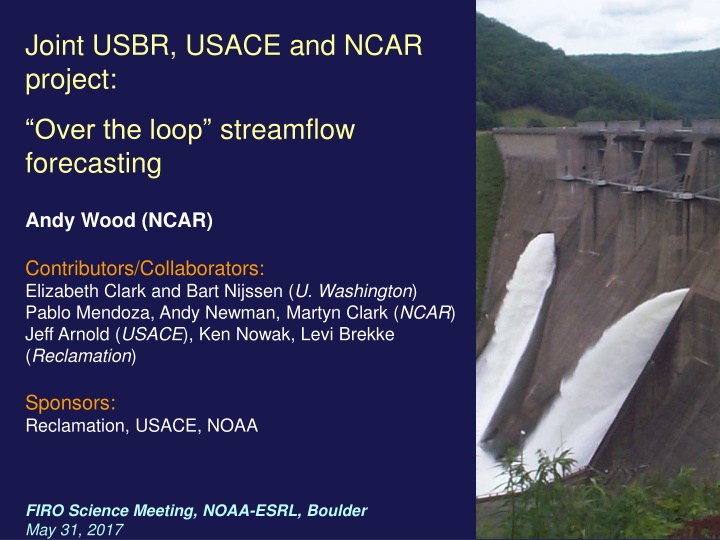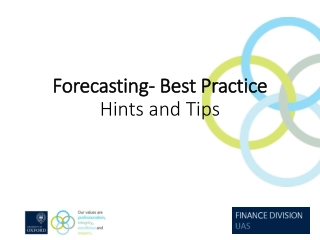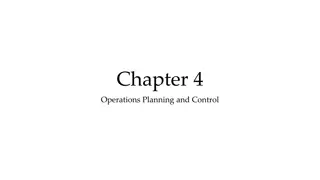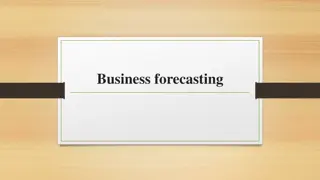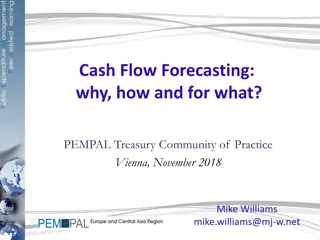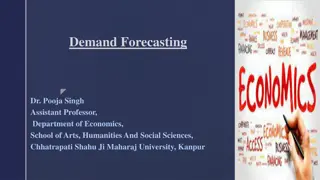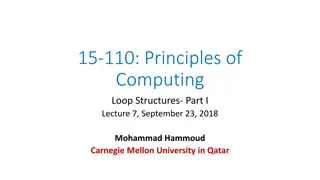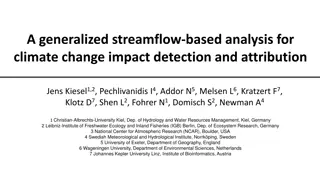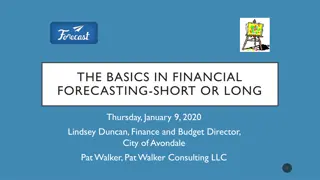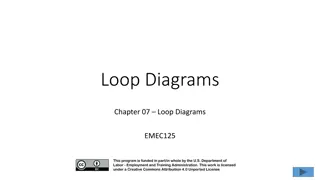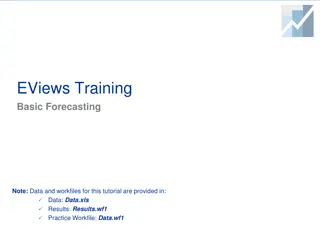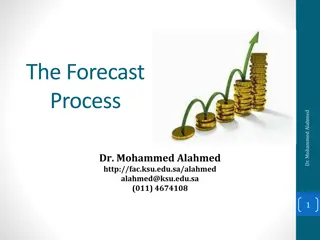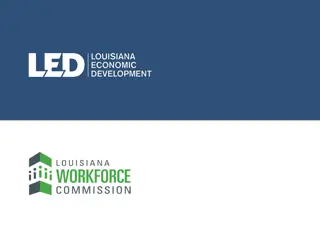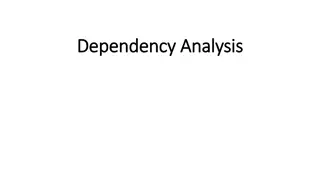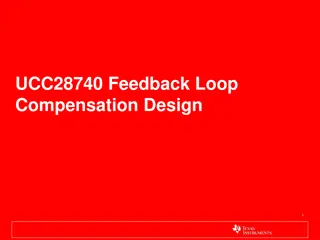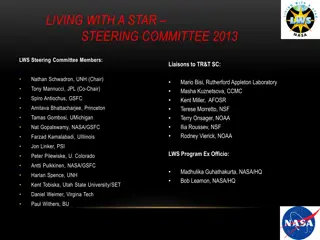Over-the-Loop Streamflow Forecasting Project Summary
Joint project by USBR, USACE, and NCAR focusing on improving streamflow forecasting using automated over-the-loop approaches. Key challenges include model calibration, data assimilation, and real-time forcings. Objectives involve building an automated system for short- to long-term flow predictions and demonstrating forecast performance for water management. Discussion on modern hydrologic prediction operations is encouraged.
Download Presentation

Please find below an Image/Link to download the presentation.
The content on the website is provided AS IS for your information and personal use only. It may not be sold, licensed, or shared on other websites without obtaining consent from the author.If you encounter any issues during the download, it is possible that the publisher has removed the file from their server.
You are allowed to download the files provided on this website for personal or commercial use, subject to the condition that they are used lawfully. All files are the property of their respective owners.
The content on the website is provided AS IS for your information and personal use only. It may not be sold, licensed, or shared on other websites without obtaining consent from the author.
E N D
Presentation Transcript
Joint USBR, USACE and NCAR project: Over the loop streamflow forecasting Andy Wood (NCAR) Contributors/Collaborators: Elizabeth Clark and Bart Nijssen (U. Washington) Pablo Mendoza, Andy Newman, Martyn Clark (NCAR) Jeff Arnold (USACE), Ken Nowak, Levi Brekke (Reclamation) Sponsors: Reclamation, USACE, NOAA FIRO Science Meeting, NOAA-ESRL, Boulder May 31, 2017
Tackling key hydrologic prediction challenges Hydrologic Forecasting: methods are a critical complement to data & models Workflow/Data Management Platform Hydro/Other Observations feedback into component improvements Historical Forcings (regional) parameter estimation objective DA verification Spinup Forcings Products, Website Streamflow & Other Outputs Appropriate Hydro/Other Models post- calibrated downscaling Forecast and Hindcast Forcings processing, forecast calibration X hindcasting, ensembles (uncertainty), benchmarking, real-time operations X X X Since the 1970s, operational forecasting has implemented key methods in real-time via mostly human forecaster effort. The biggest methodological challenges to alternatives: data assimilation (making the model accurate in real-time) model calibration especially for ungaged areas optimal model parameters are dependent on model forcings
Streamflow Forecast Challenges Challenges There has been little operational experience in the US with using over-the-loop approaches to produce streamflow forecasts hydrologic forecasting biased / erroneous forcings These are the main science challenges in Over-the-Loop Components? poor hydrologic model (parameters, structure) automatic generation of real-time forcings using methods & data that are consistent with retrospective forcings inconsistent real- time vs retro forcings automated / objective model calibration (parameter estimation) missing or bad hydromet data automated downscaling and statistical calibration to improve meteorological forecasts biased / erroneous met. forecasts automated hydrologic data assimilation automated streamflow post-processing residual hydrologic error
The Over-the-Loop Project Objectives Build an over-the-loop system (all processes automated) to produce short-range to seasonal ensemble flow predictions using currently available methods drawing methods from HEPEX ideas and philosophy Provide a public demonstration of the performance of over-the-loop forecasts for locations that are relevant to the forecasting and water management communities Promote discussion about alternative forecaster roles in a modern hydrologic prediction operations
Over-the-Loop Project Methods Model parameter estimation (calibration) local (for now) optimizations using MOCOM NWS models during development phase; VIC, mHM, SUMMA next Multi-scale Parameter Regionalization (MPR-Flex; N. Mizukami) Consistent Retro + Real-time daily ensemble forcing analysis GMET; Newman et al. (2015) ensemble forcings Jan 1970 to yesterday, daily 1/16th degree, western US regions A first of its kind GEFS ensemble (11 member) downscaling and calibration GARD (Generalized Analog Regression Downscaling) tool NCAR Ethan Gutman and Joe Hamman contributing Hydrologic data assimilation Sequential and Non-Sequential Particle Filter methods Liz Clark, Bart Nijssen (UW) contributing 5 Research supported by the major US federal water agencies: USACE and Reclamation. Co-Lead B. Nijssen
Addressing DA Challenge Ensemble Particle Filter ensemble met. forcings => ens. hydrologic states Observed Simulated Generate consistent hydrologic states representing uncertainties as basis for forecast initialization
Ensemble Forcing Generation Other Methodological choices: Topographic lapse rates derived at each grid cell for each day vs. climatology Used serially complete (filled) station data rather than only available obsvs. using only available observations Synthesize ensembles from PoP, amount & uncertainty using spatially correlated random fields (SCRFs) observations Final Product: 1/16th degree, daily 1970-present, 100 members, precipitation & temperature Example over the Colorado Headwaters Clark & Slater (2006), Newman et al. (2014, in prep)
Data Assimilation Howard Hanson inflows No data assimilation Mimic operational forecaster by selecting initial states (& inputs/parameters ) that agree best with observations Initial condition uncertainty Technically, this is formulated as a particle filter hydrological data assimilation Howard Hanson inflows Weight calculated based on 1 day of flow Initial condition uncertainty
Project Methods (cont.) Model parameter estimation local (for now) optimations using MOCOM NWS models (Snow17, Sacramento) during development phase working to link with MPR for next phase of project (N. Mizukami) Consistent Retro + Real-time daily ensemble forcing analysis GMET; Newman et al. (2015) earlier talk this session 1970 Jan 1 to yesterday, 1/16th degree, western US regions GEFS ensemble (11 member) downscaling and calibration GARD (Generalized Analog Regression Downscaling) tool Ethan Gutman with Joe Hamman contributing Hydrologic data assimilation Sequential and Non-Sequential Particle Filter methods Liz Clark and Bart Nijssen (UW), Andy Wood Streamflow post-processing Comparing 6-8 methods Pablo Mendoza (NCAR) 9 Research supported by the major US federal water agencies: USACE and Reclamation. Co-Lead B. Nijssen
Post-processing is also critical reduces residual uncertainty after other parts of the process Method Name LB Linear blending EV1 Error in variable Model Output Statistics with one variable hindcast based skill evaluation GLMPP Generalized Linear Model Post- Processor EnsPost Ensemble Post- Processor QR Quantile Regression contribution by Pablo Mendoza HUP Hydrologic Uncertainty Processor Require consistent hindcasts to implement 10 Research supported by the major US federal water agencies: USACE and Reclamation. Co-Leads B. Nijssen
Real-Time System Implementation The SHARP system is now running at NCAR to generate real time short and seasonal range forecasts for a number of pilot case study basins sample real-time workflow web monitor ecFlow -- https://software.ecmwf.int/wiki/display/ECFLOW/
Focus on case study basin study sites Initial pilot domain was the Pacific Northwest with test basins selected out of interest for water management purposes. A broader US selection of basins was also used for evaluating modeling and seasonal prediction methods. The models used initially have been the NWS lumped (Snow17/Sac/UH) and VIC run at a daily timestep. A daily timestep is too coarse for flows in some of the California basins. 12
Putting it together Raw 100-member ens init. Calibrated model objective model calibration ensemble forcings particle filter DA post-processing hindcasting Particle Filter DA Figure (top) Ensemble-initialized GEFS-based flow forecast ensembles Post-processing (eg, Blending) (middle) 5 highest weighted ICs and forecasts (bottom) same 5 ICs blended via LB
Real-time prediction example Howard Hanson Reservoir Inflow (WA) 7 day lead flow predictions made real-time
Real-time prediction example Howard Hanson Reservoir Inflow (WA)
Real-time prediction example Howard Hanson Reservoir Inflow (WA)
Real-time prediction example Howard Hanson Reservoir Inflow (WA)
Real-time prediction example Howard Hanson Reservoir Inflow (WA)
Real-time prediction example Howard Hanson Reservoir Inflow (WA)
Real-time prediction example Howard Hanson Reservoir Inflow (WA)
Real-time prediction example Howard Hanson Reservoir Inflow (WA)
Real-time prediction example Howard Hanson Reservoir Inflow (WA)
Real-time prediction example Howard Hanson Reservoir Inflow (WA)
Real-time prediction example Howard Hanson Reservoir Inflow (WA)
Real-time prediction example Howard Hanson Reservoir Inflow (WA)
Real-time prediction example Howard Hanson Reservoir Inflow (WA)
Real-time prediction example Howard Hanson Reservoir Inflow (WA)
Real-time prediction example Howard Hanson Reservoir Inflow (WA)
Over-the-Loop forecasting Seasonal Prediction Advantages benchmarking and verifying alternative methods training and applying statistical techniques objective data assimilation post-processing giving stakeholders hindcasts to support the training and evaluation of decision support systems or rules hybrid frameworks for seasonal prediction combining data-driven and modeling approaches to enhance skill transparency & reproducibility to support diagnostic evaluation
Intercomparison of range of methods Example: Hungry Horse What added value does climate information bring? Forecast skill across methods for Apr-Jul runoff only watershed only climate Watershed + climate Early in water year: we can improve WSFs using climate info. Later initialization: WSFs harder to improve upon when using a calibrated model Hybrid approaches (include watershed and climate info) most robust overall 31
An irony Since this project started, the pendulum has swung toward a different form of over-the-loop forecasting hyper-resolution large domain uncalibrated models mostly deterministic products science gaps solved by resolution traditional / conceptual calibrated models ensemble products forecast community experience intermediate scale (~1-10 km) ~250m
This presents a new challenge Restoring the relevance of hydrologic prediction science & uncertainty methods to the hyper-resolution initiatives Scaling Challenges regional model calibration (parameter estimation) 1/6th degree real-time forcings (eg temperature) spatial obstacles in downscaling and post-processing propagation of obs info in data assimilation understanding appropriate complexity of modeling scale physics tradeoffs M. Ou (UW) & N. Mizukami (NCAR)
Take-aways for FIRO Science There are two dominant philosophies in improving prediction try to eliminate error in all components of the forecast process so as to get the right answer better precip forcings and forecast higher resolution and higher complexity models more observations (meteorological, hydrological) model processes viewed literally more deterministic prediction error can never be eliminated, so make sure you can represent uncertainty ensemble meteorology and hydrology hindcastable techniques to support verification proactive approach to handling biases model processes viewed as parameterizations more probabilistic prediction It s best if the science incorporates elements of both.
Contacts NCAR Andy Wood, Lead PI (andywood@ucar.edu) Martyn Clark University of Washington Bart Nijssen (Co-PI) Elizabeth Clark
SWE Hydrologic Data Assimilation SWE measurements can be used objectively to update hydrologic model states and improve forecasts Using NWS models with Ensemble Kalman Filter (EnKF) Hindcast-based study Huang et al, 2016 (HESS)
Hydrologic Data Assimilation Example Use an ensemble method to estimate initial conditions Update those conditions with SWE observations Make ESP predictions from mean model states Assess forecast skill after assimilation
Hydrologic Data Assimilation Evaluation metrics generally show improvements for April-July ESP mean streamflow forecast for the nine case basins.
Motivation Survey of Water Managers 2012 User Needs 2012 A comprehensive survey of water management and operational users found a widespread need and desire for improved precip and streamflow forecasts at all scales.
Intercomparison of range of methods What added value does climate information bring? Example: Hungry Horse Forecast skill across methods for Apr-Jul runoff only watershed only climate Watershed + climate 41
